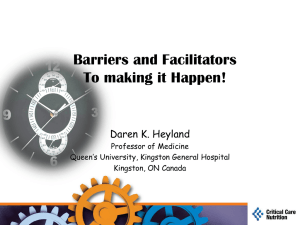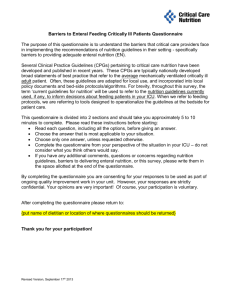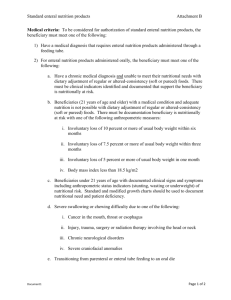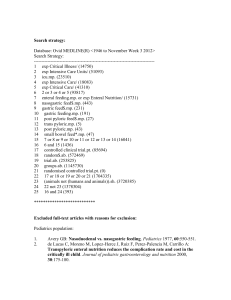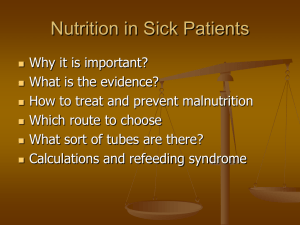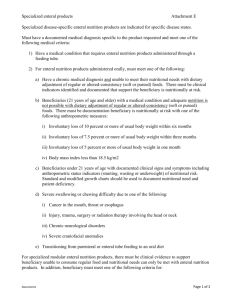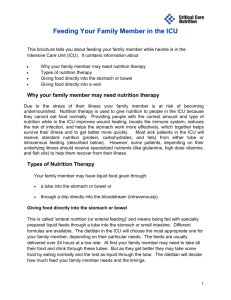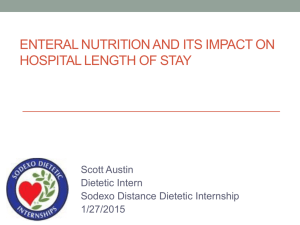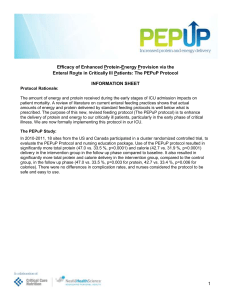here - Scottish Intensive Care Society
advertisement
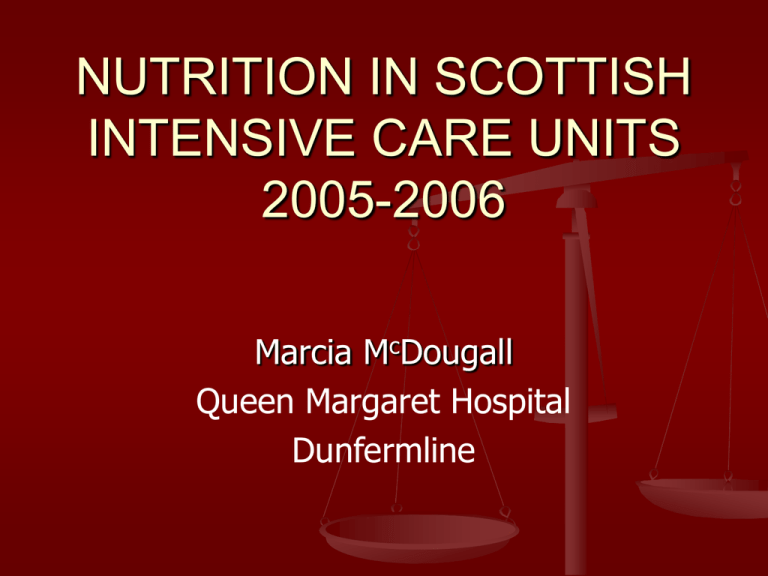
NUTRITION IN SCOTTISH INTENSIVE CARE UNITS 2005-2006 Marcia McDougall Queen Margaret Hospital Dunfermline Aims of the survey To To To To To To examine practice in Scotland examine attitudes about ICU nutrition decide what to investigate with SICS find volunteers for SICS nutrition group look at and apply existing guidelines direct future audit and research Questionnaire Sent to all general intensive care units in Scotland (24 ICUs) To lead clinician or other ICU consultant 100% response rate ( a few incomplete surveys) Results Total number Scottish ICU beds: 173 including 26 specified for level 2 care, most of which can be upgraded to Level 3 Admissions per year: approximately 8880 for the 24 units Average 51 patients/bed/year Dietitians/Nutrition Teams Dietitian attached to unit: 21/24 = 88% Visits daily in 14/21, 2-3/wk in 7 No d/w medical staff in 9 units 1 unit calls the hospital dietitian as required Nutrition team in hospital: 11/24, 7 of those attend ICU Members variable including: pharmacist, GI physician/nurse, biochemist, dietitian, nutrition nurse, anaesthetist, surgeon intensivist Teaching provided on nutrition 6 units provide no teaching on nutrition 18 have bedside teaching or formal tutorials PN – who signs prescription? 1 1 ICU trainee/cons pharmacist 1 1 biochemist 2 surgeon 18 nutrition consultant none % ICU patients receiving PN/year 35 30 25 20 Unit 15 10 5 0 L ED I F VMWX T AKN J QGSOP HBCR Average Days of PN 12 10 8 6 Unit 4 2 0 L E W D I V X T A K N J Q G S O P B C R PN administration 8 use both PIC lines and Central lines 16 use only central lines 9 use only new lines/clean port for PN 15 use used port in existing lines 5 use antibiotic-impregnated lines, 3 routinely 7 cannot start PN at the weekend Those that do use ready-made TPN bags What are your indications for stopping PN? absorbing enteral feed adequate enteral intake established enteral feed return of GI function tolerating NG feed 24 hours full enteral nutrition within 25% of nutritional goals >50% of calories given enterally and absorbed How precise should we be? CCCN suggest adequate EN is 80% of requirements How long would you persist with inadequate EN before starting PN? 8 7 6 5 No. units 4 Time 3 2 1 0 .5- 1- 2- 3d 3- 5d 5- >7 var 1d 2d 3d 5d 7d Prokinetics 1 unit never uses them 2 rarely use them 6 use metoclopramide only 13 use metoclopramide and erythromycin in sequence 1 uses a single dose of erythromycin then metoclopramide CCCN suggests metoclopramide to optimise enteral feeding Enteral Feeding All units use an NG feeding protocol Types of feed used vary but standard is either Osmolite, Jevity, Jevity Fibre, Fresubin Original or Nutrison Standard Intensivists, dietitians and nurses decide which feed to give, and 1 surgeon 23/24 units use combined EN and PN to reach nutritional goals Calorific Requirements Calculated daily by dietitian in 17/24 units, not calculated in 6 By doctor or pharmacist in 1 unit Displayed on 24 hour chart in 6 Amount by which patient has fallen behind is calculated in 11 units by dietitian but not displayed in 10 of those 6 comment that >50% below goals should trigger starting PN, 2 >25% NJ feed: patient use per year None 3 units >10/year 12 units 1-5/year 6 units 6-10/year 3 units Naso-Jejunal Feeding Is is useful? Yes 23 No 1 Who puts them in?: Surgeons/GI phys 20/24 Intensivists 3 GI nurse 1 Radiologist 2 (some overlap) All in theatre or at bedside and mostly with endoscopy Types: Tiger, Merck Corflow, Corsafe, Cook Nasobiliary tube, Fresenius Endo 250 Naso-Jejunal Feeding Barriers: 15: Poor availability and/or willingness of skilled operators, poor awareness in theatre 4 No barriers, 1 discussed but not implemented Indications: failure to establish NG feed gastric stasis gastric outlet obstruction high anastomosis emergency/elective laparotomies Glutamine 16 14 12 10 Units 8 6 4 2 0 Not used In PN In PN and EN In PN and separate enteral Separate enteral Immunonutrition Other than Glutamine is not used in any Scottish unit at present Interest in omega-3 fatty acids and antioxidants is building but literature so far is inconclusive. ‘The way forward is to test single nutrients in large scale, well designed, randomized trials of homogeneous patient populations’ Daren Heyland What is the maximum amount of time an ICU patient should go without nutrition? 10 9 8 7 6 Units 5 4 3 2 1 0 Days 0.5- 11d 2d 2d 3d 25d 5d 57d Issues We need better communication between medical staff and dietitians. Better teaching for all trainees is required. There is a large variation in the amount and indications used for prescription of PN. Lack of clarity over nutritional goals. Issues Do we ensure early feeding in our patients? When should we start/stop PN? Should we be using Glutamine pending SIGNET results? ESPEN/CCCN/ICS What is the value of feeding guidelines (e.g. CCCN, ESPEN)? Apparent lack of awareness of these. Issues What is the best type of line for PN? Which prokinetic to use, when and for how long? Are N-J tubes better than NG tubes? Are N-J tubes preferable to PN for inadequate enteral feeding? What is the best way to put them in and by whom? Early Nutrition How important is it to start nutrition of any kind within 24 hours? Opinion in Scotland is divided (maximum time without nutrition 12 hours – 7 days) There are few RCTs on early nutrition in critically ill patients But they do suggest earlier (<24 hours) is better even with PN if enteral impossible Nutrition Group CATs and reviews: 1st phase: Glutamine, early feeding, and nasojejunal vs nasogastric feeding Looking at nutritional assessment in ICU Preparation of audit tools for use in Scottish units Contribution to education programmes for ICU trainees and others in the future Promotion of guidelines Acknowledgements Peter Andrews Grant Carnegie
